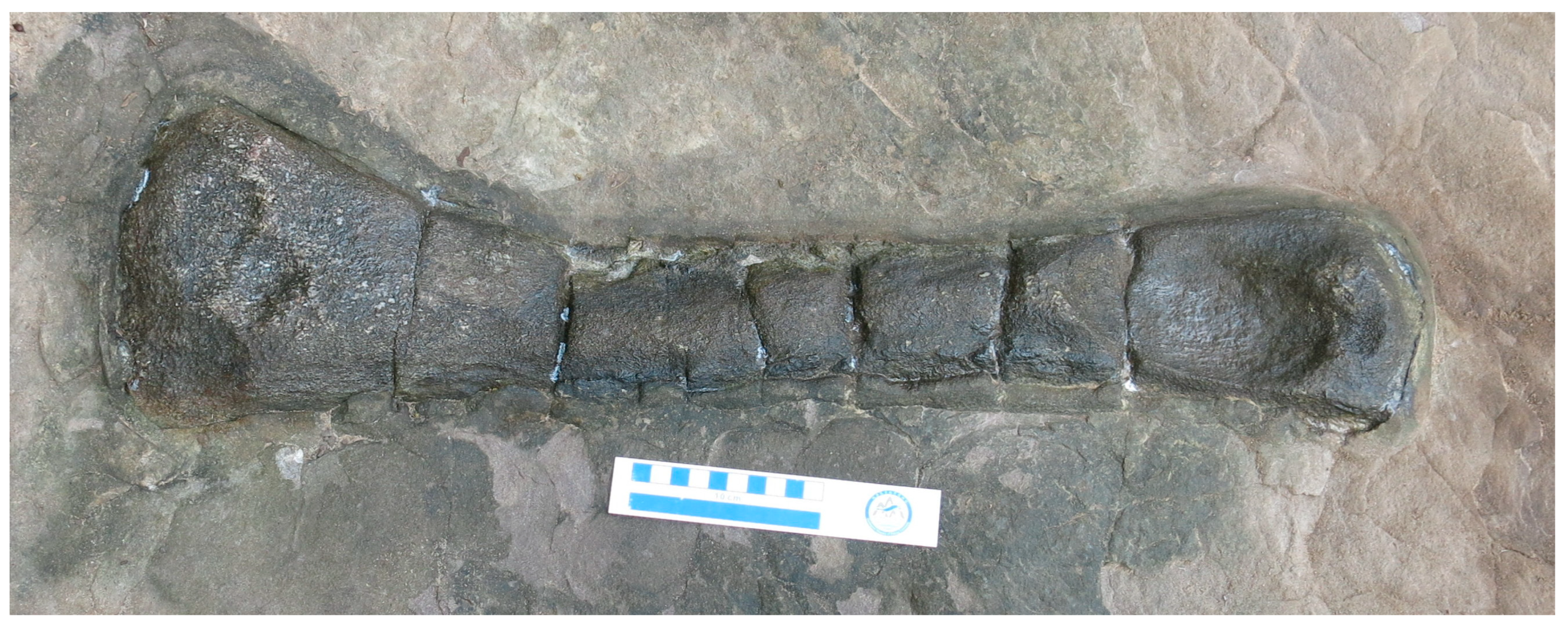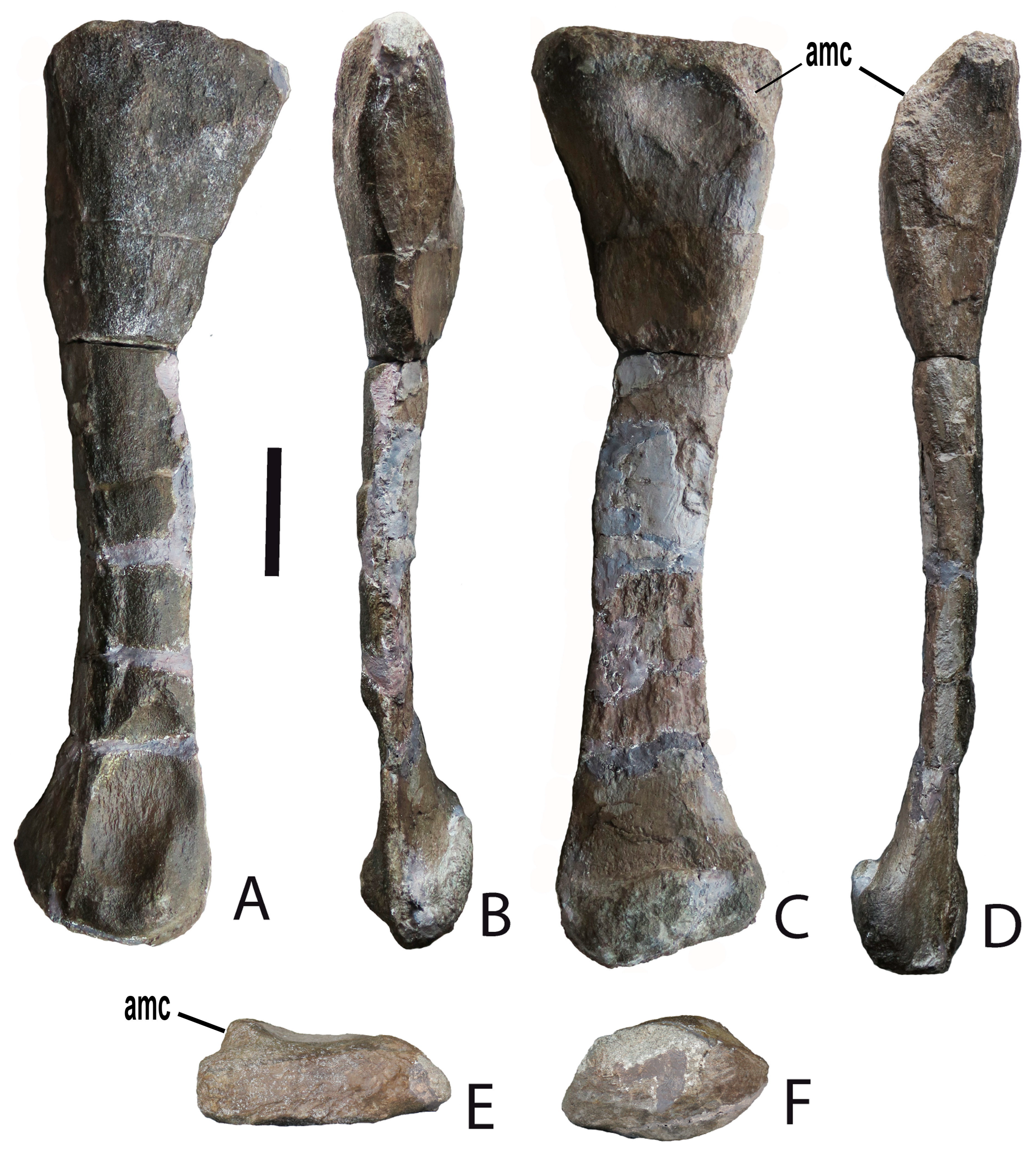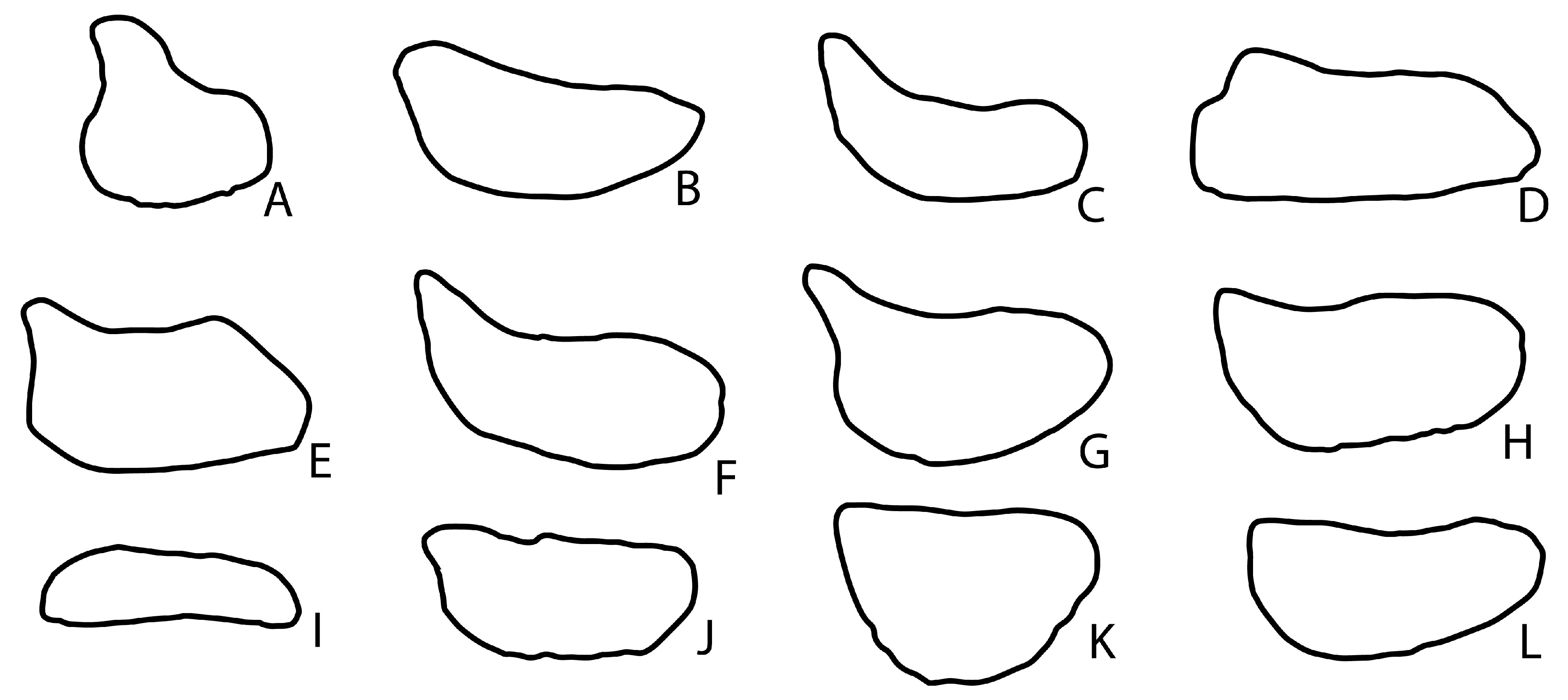The First Dinosaur from the Kingdom of Cambodia: A Sauropod Fibula from the Lower Cretaceous of Koh Kong Province, South-Western Cambodia
Abstract
:1. Introduction
2. Geographical and Geological Settings
3. Material and Methods
4. Systematic Paleontology
4.1. Description
4.2. Measurements
| Overall length: | 700 mm |
| Minimum craniocaudal width of shaft: | 85 mm |
| Craniocaudal length of proximal articular surface: | 185 mm |
| Mediolateral width of proximal articular surface: | 90 mm |
| Craniocaudal length of distal articular surface: | 152 mm |
| Mediolateral width of distal articular surface: | 76 mm |
5. Discussion
6. Conclusions
Author Contributions
Funding
Data Availability Statement
Acknowledgments
Conflicts of Interest
References
- Hoffet, J.H. Découverte du Crétacé en Indochine. C. R. Acad. Sci. Paris 1936, 102, 1867–1870. [Google Scholar]
- Buffetaut, E.; Suteethorn, V.; Tong, H. Dinosaur assemblages from Thailand: A comparison with Chinese faunas. In Papers from the 2005 Heyuan International Dinosaur Symposium; Lü, J., Kobayashi, Y., Huang, D., Lee, Y.N., Eds.; Geological Publishing House: Beijing, China, 2006; pp. 19–37. [Google Scholar]
- Sone, M.; Hirayama, R.; He, T.; Yoshida, M.; Komatsu, T. First dinosaur fossils from Malaysia: Spinosaurid and ornithischian teeth. In Proceedings of the Second International Symposium on Asian Dinosaurs, Bangkok, Thailand, 19–20 November 2015; Nakhon Ratchasima Rajabat University: Nakhon Ratchasima, Thailand; Department of Mineral Resources: Bangkok, Thailand, 2015; p. 18. [Google Scholar]
- Liard, T. Preliminary Report on Vertebrate Footprints from Ratanak Mondul District, Battambang Province, Cambodia on 19–20 of August 2016; Sirindhorn Museum, Department of Mineral Resources: Sahat Sakhan, Thailand, 2016; 11p. [Google Scholar]
- Fleuriot de Langle, P. Koh Kong. Carte Géologique de Reconnaissance à 1/200 000; Editions du Bureau de Recherches Géologiques et Minières; Service National des Mines, de la Géologie et du Pétrole: Paris, France, 1972; 9p. [Google Scholar]
- Corsin, P.; Desreumaux, C. Découverte d′une flore néocomienne dans les «grès supérieurs» de Bokor (Cambodge méridional). Ann. Soc. Géol. Nord 1972, 92, 199–212. [Google Scholar]
- Fontaine, H.; Workman, D.R. Review of the geology and mineral resources of Kampuchea, Laos and Vietnam. In Proceedings of the Third Regional Conference on Geology and Mineral Resources of Southeast Asia, Bangkok, Thailand, 14–18 November 1978; Nutalaya, P., Ed.; Asian Institute of Technology: Bangkok, Thailand, 1978; pp. 540–601. [Google Scholar]
- Racey, A. Mesozoic red bed sequences from SE Asia and the significance of the Khorat Group of NE Thailand. Geol. Soc. London Spec. Pub. 2009, 315, 41–67. [Google Scholar] [CrossRef]
- Buffetaut, E.; Lim, V.; Sophady, H. First dinosaur bone from Cambodia: A sauropod fibula from the Late Mesozoic of Koh Kong Province. In Current Studies on Past Biodiversity in Southeast Asia, Abstracts Volume. J. Ass. Paleont. Fr. Num. Sp. 2021, 1, 11. [Google Scholar]
- Carò, F.; Polkinghorne, M.; Douglas, J.G. Stone materials used for lintels and decorative elements of Khmer temples. Metrop. Mus. Stud. Art Sci. Technol. 2014, 2, 51–68. [Google Scholar]
- Wilson, J.A.; Upchurch, P. Redescription and reassessment of the phylogenetic affinities of Euhelopus zdanskyi (Dinosauria: Sauropoda) from the Early Cretaceous of China. J. Syst. Palaeont. 2009, 7, 199–239. [Google Scholar] [CrossRef]
- McIntosh, J.S. Sauropoda. In The Dinosauria; Weishampel, D.B., Dodson, P., Osmólska, H., Eds.; University of California Press: Berkeley, CA, USA, 1990; pp. 345–401. [Google Scholar]
- Wilson, J.A.; Sereno, P.C. Early evolution and higher level phylogeny of sauropod dinosaurs. Soc. Vert. Paleont. Mem. 1998, 5, 1–68. [Google Scholar]
- D’Emic, M.D. The early evolution of titanosauriform sauropod dinosaurs. Zool. J. Linn. Soc. 2012, 166, 624–671. [Google Scholar] [CrossRef]
- Ksepka, D.T.; Norell, M.A. Erketu ellisoni, a long-necked sauropod from Bor Guve (Dornogov Aimag, Mongolia). Am. Mus. Nov. 2006, 3508, 1–16. [Google Scholar] [CrossRef]
- You, H.; Tang, F.; Luo, Z. A new basal titanosaur (Dinosauria: Sauropoda) from the Early Cretaceous of China. Acta Geol. Sin. 2003, 77, 424–429. [Google Scholar]
- Allain, R.; Taquet, P.; Battail, B.; Dejax, J.; Richir, P.; Véran, M.; Limon-Duparcmeur, F.; Vacant, R.; Mateus, O.; Sayarath, P.; et al. Un nouveau genre de dinosaure sauropode de la Formation des Grès supérieurs (Aptien-Albien) du Laos. C. R. Acad. Sci. Paris Sci. Terre Plan. 1999, 329, 609–616. [Google Scholar] [CrossRef]
- Swinton, W.E. New discoveries of Titanosaurus indicus Lyd. Ann. Mag. Nat. Hist. 1947, 14, 112–123. [Google Scholar] [CrossRef]
- Mannion, P.D.; Upchurch, P.; Barnes, R.N.; Mateus, O. Osteology of the Late Jurassic Portuguese sauropod dinosaur Lusotitan atalaiensis (Macronaria) and the evolutionary history of basal titanosauriforms. Zool. J. Linn. Soc. 2013, 168, 98–206. [Google Scholar] [CrossRef]
- Hatcher, J.B. Diplodocus (Marsh): Its osteology, taxonomy, and probable habits with a restoration of the skeleton. Mem. Carnegie Mus. 1901, 1, 1–63. [Google Scholar] [CrossRef]
- Huene, F. von. Sichtung der Grundlagen der jetzigen Kenntnis der Sauropoden. Eclog. Geol. Helvet. 1927, 20, 444–470. [Google Scholar]
- Ouyang, H.; Ye, Y. The First Mamenchisaurian Skeleton with Complete Skull: Mamenchisaurus Youngi; Sichuan Science and Technology Press: Chengdu, China, 2002; 111p. [Google Scholar]
- Osborn, H.F.; Mook, C.C. Camarasaurus, Amphicoelias and other sauropods of Cope. Mem. Am. Mus. Nat. Hist. 1921, 3, 247–387. [Google Scholar] [CrossRef]
- Gilmore, C.W. Osteology of Apatosaurus with special reference to specimens in the Carnegie Museum. Mem. Carnegie Mus. 1936, 11, 175–300. [Google Scholar] [CrossRef]
- Janensch, W. Die Gliedmaszen und Gliedmaszengürtel der Sauropoden der Tendaguru-Schichten. Palaeontogr. -Suppl. 1961, 3, 177–235. [Google Scholar]
- Wiman, C. Die Kreide-Dinosaurier aus Shantung. Palaeont. Sin. C 1929, 6, 1–67. [Google Scholar]
- Martin, V.; Suteethorn, V.; Buffetaut, E. Description of the type and referred material of Phuwiangosaurus sirindhornae, Martin, Buffetaut & Suteethorn, 1994, a sauropod from the Lower Cretaceous of Thailand. Oryctos 1999, 2, 39–91. [Google Scholar]
- Canudo, J.I.; Royo-Torres, R.; Cuenca-Bescós, G. A new sauropod: Tastavinsaurus sanzi gen. et sp. nov from the Early Cretaceous (Aptian) of Spain. J. Vert. Paleont. 2008, 28, 712–731. [Google Scholar] [CrossRef]
- Rose, P.J. A new titanosauriform sauropod (Dinosauria: Saurischia) from the Early Cretaceous of central Texas and its phylogenetic relationships. Palaeont. Electr. 2007, 10, 1–65. [Google Scholar]
- Borsuk-Bialynicka, M. A new camarasaurid sauropod Opisthocoelicaudia skarzynskii gen. n., sp. n. from the Upper Cretaceous of Mongolia. Palaeont. Polon. 1977, 37, 5–64. [Google Scholar]
- Otero, A. The appendicular skeleton of Neuquensaurus, a Late Cretaceous saltasaurine sauropod from Patagonia, Argentina. Acta Palaeont. Polon. 2010, 55, 399–426. [Google Scholar] [CrossRef]
- Gallina, P.A.; Apesteguia, S. Postcranial anatomy of Bonitasaura salgadoi (Sauropoda, Titanosauria) from the Late Cretaceous of Patagonia. J. Vert. Paleont. 2015, 35, e924957. [Google Scholar] [CrossRef]
- Mannion, P.D.; Upchurch, P.; Jin, X.; Zheng, W. New information on the Cretaceous sauropod dinosaurs of Zhejiang Province, China: Impact on Laurasian titanosauriform phylogeny and biogeography. R. Soc. Open Sci. 2019, 6, 191057. [Google Scholar] [CrossRef]
- Poropat, S.F.; Frauenfelder, T.G.; Mannion, P.D.; Rigby, S.L.; Pentland, A.H.; Sloan, T.; Elliott, D.A. Sauropod dinosaur teeth from the lower Upper Cretaceous Winton Formation of Queensland, Australia and the global record of early titanosauriforms. R. Soc. Open Sci. 2022, 9, 220381. [Google Scholar] [CrossRef]
- Moore, A.J.; Upchurch, P.; Barrett, P.M.; Clark, J.M.; Xu, X. Osteology of Klamelisaurus gobiensis (Dinosauria, Eusauropoda) and the evolutionary history of Middle–Late Jurassic Chinese sauropods. J. Syst. Palaeont. 2020, 18, 1299–1393. [Google Scholar] [CrossRef]
- Mazzetta, G.V.; Christiansen, P.; Fariña, R.A. Giants and Bizarres: Body size of some southern South American Cretaceous dinosaurs. Hist. Biol. 2006, 16, 71–83. [Google Scholar] [CrossRef]





Disclaimer/Publisher’s Note: The statements, opinions and data contained in all publications are solely those of the individual author(s) and contributor(s) and not of MDPI and/or the editor(s). MDPI and/or the editor(s) disclaim responsibility for any injury to people or property resulting from any ideas, methods, instructions or products referred to in the content. |
© 2023 by the authors. Licensee MDPI, Basel, Switzerland. This article is an open access article distributed under the terms and conditions of the Creative Commons Attribution (CC BY) license (https://creativecommons.org/licenses/by/4.0/).
Share and Cite
Lim, V.; Buffetaut, E.; Tong, H.; Cavin, L.; Pann, K.; Ngoeun, P.P. The First Dinosaur from the Kingdom of Cambodia: A Sauropod Fibula from the Lower Cretaceous of Koh Kong Province, South-Western Cambodia. Foss. Stud. 2023, 1, 49-59. https://doi.org/10.3390/fossils1010006
Lim V, Buffetaut E, Tong H, Cavin L, Pann K, Ngoeun PP. The First Dinosaur from the Kingdom of Cambodia: A Sauropod Fibula from the Lower Cretaceous of Koh Kong Province, South-Western Cambodia. Fossil Studies. 2023; 1(1):49-59. https://doi.org/10.3390/fossils1010006
Chicago/Turabian StyleLim, Vanchan, Eric Buffetaut, Haiyan Tong, Lionel Cavin, Kimchhay Pann, and Phalline Polypheakdey Ngoeun. 2023. "The First Dinosaur from the Kingdom of Cambodia: A Sauropod Fibula from the Lower Cretaceous of Koh Kong Province, South-Western Cambodia" Fossil Studies 1, no. 1: 49-59. https://doi.org/10.3390/fossils1010006
APA StyleLim, V., Buffetaut, E., Tong, H., Cavin, L., Pann, K., & Ngoeun, P. P. (2023). The First Dinosaur from the Kingdom of Cambodia: A Sauropod Fibula from the Lower Cretaceous of Koh Kong Province, South-Western Cambodia. Fossil Studies, 1(1), 49-59. https://doi.org/10.3390/fossils1010006







